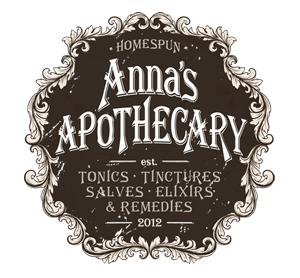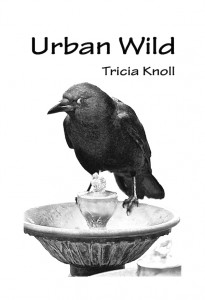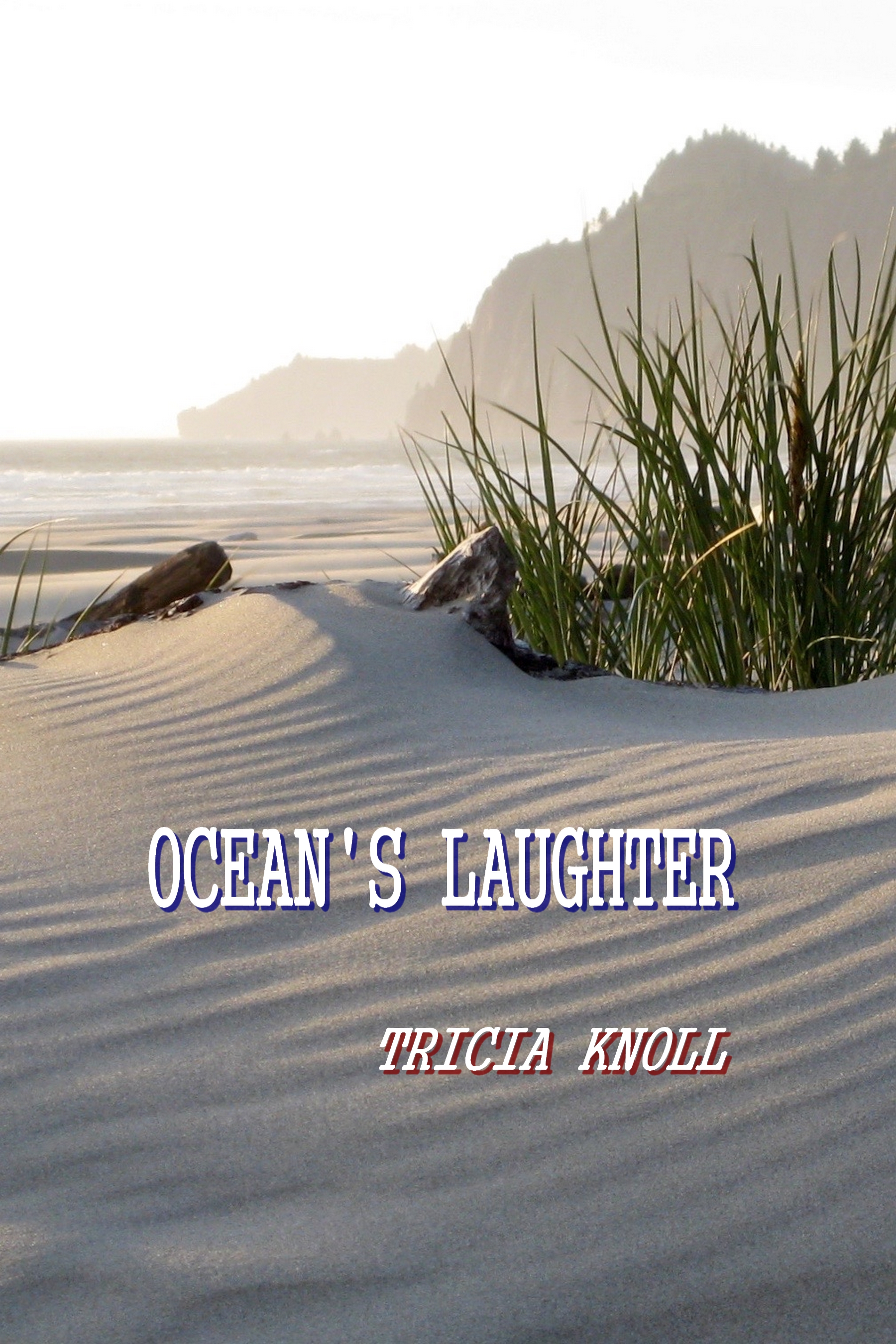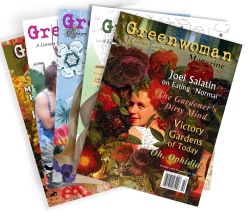
Lily and Garrett, her black Rosecomb rooster.
As we left the story last week, Alice, our young Dalmatian, had dug under the chicken run and the chickens had escaped. As we had just lost a chicken to drowning the week before (when a cat menaced them and Jessica flew into the children’s swimming pool) I was, needless to say, freaking out.
Presenting the conclusion of The Chicken Chronicles.
–Sandra Knauf
* * *
The chickens escaped and again I ran around, heart racing, hunting and gathering. This time I found only three.
The other Sebright was missing, as was Zelda, the female Silkie. Finding evidence of Alice’s digging at the wire fence surrounding the vegetable garden, right next to the chicken shack, I investigated there. Sitting very still in a patch of grass was the Sebright. I took him into the house and examined him, discovering some minor scratches under a wing and a scrape on the lower right leg. He had apparently injured himself trying to escape Alice by squeezing under a low spot in the fence. Vehicle-less, I phoned our veterinarian. Dr. Westrich. He told me that if I couldn’t come in I should clean the wounds with hydrogen peroxide, keep the bird in a quiet place, and watch him. He also said that if the other one hadn’t been found yet it probably meant that she wouldn’t be found alive.
I made a box for the male Sebright named Suzie in the girl’s playroom and went to search for Zelda again. I found her immediately–alive and well! She had been hiding out on the other side of the enclosed run–between it and a bale of straw. I spotted her as she ventured out into the open, peeping frantically to her coop-mates on the other side. I quietly thanked whoever was in charge of her safety for having mercy on me as well.
Early the next morning I found the Sebright hopping around his box. I picked him up for a minute and murmured consolingly to him, and when I left he made loud, distressed peeps. I comforted him again and again he cried out when I left. The third time I went in he was perched on top of the box on his good leg. Maybe he would be okay outside with his buddies, I thought, it was apparent he would be miserable inside alone. In the chicken shack, his brothers and sister, noisy and excited, gathered around him, but he was hopping around so pitifully I changed my mind about leaving him. He needed rest. As I walked away from the other chickens with Suzie pressed against my breast, he began to protest–loudly and incessantly. With a nagging conscience, I returned him to his flock.
The next couple of days he seemed to be okay except for the leg–I could tell it was causing him pain. As the other chickens filed out of the coop into the garden to scratch for bugs and eat young weeds he protested loudly, then reluctantly hopped along behind them. Otherwise he ate, drank, and rested normally. I checked twice daily for signs of infection and found none.
On the third day I noticed the bottom of his injured leg was swollen. I called Dr. Westrich. Although he didn’t treat birds, he agreed to check him out that afternoon. I figured the bird’s leg was infected and that it would be drained and the doctor would put him on antibiotics. I wasn’t really worried, and thought it would be an educational experience for the girls.

Zora, the girls’ friend Eva, and Zelda, the Silkie hen. On another dress-up day.
Christiana, a friend of the girls’, was spending the day with us and her mother said she could come along. As I carried the basket holding Suzie into the veterinarian’s office, three little girls dressed up in tea party clothes–long colorful dresses, shawls, rhinestone jewelry and parasols–traipsed behind me. In the examining room, we gathered around Dr. Westrich as he gently lifted the bird from the basket, speaking to him softly and reassuringly.
He examined him for only a few moments before pointing out the area above the swelling. “Do you see here, where the leg bends?” he said. “If you compare it with the other leg, you can see it shouldn’t do that. It’s broken.”
My heart sank.
“And his foot doesn’t have the healthy pink color that the other has. That shows that the area is not getting circulation.”
“So it’s getting gangrene?” I asked, completely horrified.
“It looks like that’s probably what’s happening.”
I asked if it could be amputated and he said he thought it could. He told me he thought the chicken would eventually be able to get around like other animal amputees, but that he didn’t do surgery on birds. He said he’d call a doctor he knew, see what he thought, and try to set up an appointment.
The children had been silently taking in the unfolding drama. Zora now spoke. “Do we have to watch the other doctor do that?”
“God no!” I blurted.
The doctor, father of six grown children of his own, smiled at me sympathetically.
We waited at the front desk. After a few minutes Dr. Westrich came back out and carefully explained, “I spoke with Dr. Abernathy. He said that in the case of amputations, the birds eventually develop a disease, an arthritic condition in the other leg, that ultimately debilitates them.”
“So there’s nothing that can be done?” I asked tearfully.
“You could go ahead with the amputation,” he said, “ but I wouldn’t recommend it.”
“We’d be putting off the inevitable . . .” I paused, trying to find an escape route from reality. “Are you sure it would be the same for him, since he’s a miniature chicken? They only weigh about a fourth as much as a regular-sized bird.”
“I’m afraid so.”
“I can’t imagine putting him through more than I already have.”
“We can euthanize him here.”
“I think that would probably be best.” I looked over at the girls chatting happily near the waiting room’s aquarium. I felt dread, devastation, and a large measure of self-loathing.
“You can use the examining room to talk to them,” Dr. Westrich said quietly.
Trying hard to hold on to what little composure I felt I had left, I called the girls back into the examining room. Crouched before them, tears brimming, I told them what had to be done.
Zora, in a consoling tone I’d never heard her use before said, “Okay, Mom.”
Lily’s eyes filled with tears for a few moments before asking, “Are we going to bury him next to Jessica?”
It felt like I was co-starring in the absolute worst, most melodramatic soap opera of all time–and I could not escape–the scene had to play out. We went to say our good-byes to Suzie. Before taking him away, the doctor asked if we wanted the body to take home, or if they should dispose of it.
“Please do it here,” I said. I knew I was copping out. The girls could probably handle it, but I could not. Not two pet burials in as many weeks, even if they were “just” chickens.
The doctor brought back the basket and left the room to begin the euthanasia. Taking out my checkbook and pen, I asked the receptionist how much the bill came to.
“The doctor says there’s no charge.”
“You can’t be serious. I have to pay you.”
“He said not to charge you.” She smiled. “So don’t worry about it.”
When I got home I found I had to make a decision. On one hand, I could not bear any more tragedies. If anything else happened, the chicken experiment was officially over. And I meant it. We were down to four chickens and three were male. And I wasn’t sure how long we’d be keeping them. After a summer of work and dreams we had one hen. On the other hand, we’d gone this far–we’d built the covered run, I’d now laid cement blocks around the parameter so the damn dog (I’d cursed her bitterly when we returned home that day) couldn’t dig under it. I had nearly twenty-five pounds of feed, plus all the poultry paraphernalia–waterers and feeders, vitamins, a wire cage. The girls had bonded with their favorites, who were luckily still alive, and we’d taken a lot of pictures, documenting our “fun,” including some wonderful ones of the girls holding the birds while wearing their tea-party clothes. I decided I’d give it one more try. But to make it worth while, I needed to find a few replacement hens.

Zora and her bantam Cochin rooster, Kayley.
I browsed the local paper’s Classifieds under “Farm Animals” and found no chickens for sale. Not profitable enough in the big city, I deduced. The County Fair had come and gone, and the only other places I knew of to buy poultry this time of year were the weekly livestock auction in the rural town of Calhan and the State Fair, now going on in the nearby city of Pueblo. Still quite the livestock novice, I was more than a little wary of buying at auction, so I called the State Fair. A helpful woman informed me they’d be selling chickens from the Junior Division Livestock Show in a couple of weeks.
The weekend before our trip to the fair the girls and I had a yard sale to raise money for our chicken purchases and on Friday of Labor Day weekend we set out at 9 A.M.. The trunk contained our outfitting: a wood-sided red wagon, two cages, and a basket, all made comfy with soft straw bedding. I had recovered from the previous tragedies and was looking forward to our hen quest, hoping to find my own objet d’desire, a Mille Fleur Booted Bantam that I’d seen in the chicken books. “Mille fleur” is French for thousand flowers, and “booted” refers to this breed’s feathered legs. It’s a fancy tan, black, and white bird, with feathers that are spangled, mottled, stippled pattern, or sometimes all three. Some of the tail feathers are two toned–tan on one side and black on the other, and most have white tips. Lily says they look like they have white polka dots. She decided she wanted to find a black chicken, to pair with Garrett, and Zora hoped to find either another Cochin or an Araucana.
At the fair, we found a parking spot near the entrance. The morning air was refreshing and the grounds quiet. Andy came along but we couldn’t stay long because he had to return to work. After taking Zora and Lily on a quick run through the Arts and Crafts Building while Andy browsed the new trucks, we headed for the Small Livestock Building. We made a bee-line for the chickens, passing areas filled with pigeons, ducks, geese, turkeys, and rabbits. The sale had begun at 8 A.M., over a fourth of the cages were empty, and buyers milled about. The pressure was on.
Searching through cages of bantams, we found no Cochins or Araucanas, but I located a half dozen Mille Fleurs, and my decision was made. Lily fell in love with a black hen who wasn’t for sale. Her second choice was a little Rhode Island Red. The hen seemed gentle and was handsome–her dark reddish-brown body embellished with black, lacy-topped tail feathers. She was an American girl, something new for our collection. I heartily approved. The Polish breed chickens, referred to as such even though they are thought to have originated in Belgium, caught my eye. They’re the type with the big feathery topknots that resemble haute couture hats from the 1950’s. I call them Dr. Seuss birds. I liked them but Zora couldn’t be persuaded into getting one; she declared them ugly.
She took her time selecting her perfect pullet–a medium-sized mixed breed. The young female was admittedly beautiful. Her body was graceful, tapered, like the Sebrights’, but she was an Amazon. Her long neck displayed a multitude of thin, white, vertical feathers, setting off a body tastefully speckled in black and white. Her wing feathers were tipped white, and her tail feathers black–the latter sticking up at a haughty angle. She had long, slate blue legs, and her head featured sharp golden-brown eyes, small red comb, and wattles. After being around them a while, one can sense a bird’s personality. Lily’s Rhode Island Red and my Mille Fleur were easy to read–they were mellow. This bird was different. I detected an attitude of arrogance.
“Are you sure?” I asked Zora. “Why don’t we look around one more time?”
“I want this one,” she said.
I looked at the price on the cage. Twenty-five dollars. The hen I’d picked out was ten and Lily’s was only six. But I knew there was no use trying to persuade Zora otherwise, she was a girl who knew what she wanted. Always had been. From birth.
As we were paying for the birds a photographer from the Pueblo Chieftain came up and asked if he could take a few pictures. Enthusiastic, but wary of having both Zora and Lily hold birds they were unfamiliar with at the same time, I asked that he photograph Zora first. She happened to be wearing an ensemble–a black and white patterned dress with white collar and matching beret, both embellished with small, red cloth roses–that perfectly matched her new chicken. Then he photographed chubby little Lily, whose hair needed brushing (though I didn’t notice it at the time), and whose dark brown, blue, and black-checked dress probably made the Rhode Island Red nearly disappear on film.
As a final shot he posed them together. It became the final shot because Zora’s bird got away and had to be chased down the long aisle of caged birds by a man with a net. While this took place, Andy returned. He’d been gone most of the time, visiting the hot tub display.
“What’s going on?” he asked, eyeing the photographer.
“Oh, nothing. Just memorializing the occasion.” I replied a bit bitchily. “This photographer asked if he could take pictures for the newspaper.”
“Pictures for the paper?”
“Yeah, and you missed it.”
We loaded the chickens into the cages and basket, then into our little red wagon. In the car the girls each happily held a caged bird, and I kept my chicken-in-a-basket with me in the front seat. It crossed my mind it would be very weird indeed if we got into an accident with three chickens riding with us inside the car. The girls chattered in the back, picking out names for their new pets and talking about being in the newspaper. Lily declared, “Now we’re going to be famous. We won’t have to go to school anymore!” We all laughed, but I had a sinking feeling. Knowledgeable about photography, I felt almost certain they would use Zora’s picture. Either way, one of them would be disappointed, unless they used the one of them together, which I thought unlikely. I tried to broach the subject, but the girls were too jolly to consider anything negative.
Zora named her hen Aphrodite, after the Greek goddess of love and beauty. Lily’s favorite goddess was Athena, the goddess of war and wisdom, so that became the Rhode Island Red’s name, and they christened mine Hera, queen of the gods (we’d been reading Greek mythology that summer). I loved their choices. One urban chicken farmer I knew of had named all her hens after country and western stars–Reba, Dolly, and so on, so I was pleased that the girls had picked up a theme of their own, without my help.
Since the chickens were all females, introducing them to the flock went off without a hitch. That night at dusk I slipped them through the door and after a few clucks and rustlings everything went quiet.
The next day they began to get to know one another and re-establish the pecking order. I wasn’t sure who was at the very top, it was either Zora’s Kayley or Lily’s Garrett–but Aphrodite asserted her dominance right away. Towering over them all, she stretched her neck high and challenged them to question her authority. The girls screamed as she pecked at each and every one of the other chickens, including the males, when they were so insolent as to not bow down to her majesty. After a few kicks and pecks sent back her way, however, she realized that the boys were supposed to be the leaders and she began to take on a more ladylike demeanor. And I stopped calling her Mighty Aphrodite, which irritated Zora. My bird, meek Hera, queen of all the gods and goddesses, immediately sunk to the absolute bottom of the order, and in her position usually stayed several feet away from the other chickens most of the time. She was the last to approach the daily pan of table scraps. Gentle and wise Athena took a middle rank.
The day after we brought them home, in late afternoon, Zora and Lily came running into the house. “We found an egg, we found an egg!” they yelled excitedly, holding the small, light brown gift from Athena. It was absolute magic to them, as if they’d discovered a jewel in the nesting box straw. I felt proud too–our very first egg.
I called the paper and found out that it was indeed Zora’s picture they used in the Saturday edition. Lily was upset when I broke the news, but not as upset as when we finally got our copies of the paper in the mail the next week. There, on page 5A, we saw a full-color, six-inch by nine-inch picture of Zora holding Aphrodite. An accompanying article flashed the headline: “Lots of Cool Chicks at the Fair.” Lily took one look and ran out of the house. We could hear her through the opened back door, at the swing set, crying as if her heart would break. Taking only a few seconds to marvel at the picture (we were expecting a small black and white) and how fun it all almost was, I went to try to comfort Lily.
She was swinging, and crying so hard her face was blotched red and white. I had never seen her so upset. “Why did they use Zora’s and not mine? Everybody thinks Zora is better than me.”
“That’s not true, Lily. Her chicken just happened to show up better against her clothes. I’m sure that’s why they used it. Please don’t cry, honey.”
I told her that no one in this whole city of Colorado Springs would even see the picture because you can’t even buy a paper from Pueblo here (I’d checked). I told her that no one we knew would even know Zora was in the paper unless we showed them. I told her about other members of the family who’d been in the paper or on television for fun things and that her turn would surely come soon too. Of course nothing I said was good enough to soothe her. I learned yet another lesson in motherhood. I did not expect Lily, who had always been very easy-going, to be so jealous, so traumatized. I felt incredibly stupid.
I wondered if a summer of ups and downs in the arena of backyard chicken raising had been worth the roller coaster ride after all.
My answer came several weeks later when Lily’s preschool teacher asked if I could bring the bantys in for “Sharing Time.” I decided to bring the three gentlest birds, Kayley, Jane, and, of course, our egg-layer Athena.
I prepared for the talk by gathering some feathers, boiling a few eggs, store-bought large and bantam for size comparison, and hauling out our globe so I could show the children where all chickens originated, the island of Java. As I lugged in the wooden cage holding Kayley and Athena, Lily looked up at me with sparkling eyes. The teacher told me I had five minutes. First I presented Jane, the Silkie, who was in a separate basket. I talked about his unique feathers and where his breed was from (the same place the Disney character Mulan was from!) I passed around feathers and eggs. Then, as I went to get Kayley, I asked Lily if she’d help with Athena. She deftly gathered up her little hen and was immediately surrounded by classmates who wanted to pet and hold her. It was Lily’s turn in the spotlight.
In the car a little while later she said, “Mom, I learned something today.”
I looked in the rear-view mirror at Lily in the backseat. “What’s that, sweetie?”
“That happiness can make tears come to your eyes.”
“What?”
“I was so happy when I saw Athena I felt like crying–and then I couldn’t stop smiling.”
* * *
It had been one intense summer. If someone had told me what was going to happen in our little experiment–the profound highs and lows, the multitude of things to learn, to question, and to feel, over something so seemingly, inanely, simple–I wouldn’t have believed it. Like an egg incubating under the warm down of its mother’s bosom, the process of learning, of experiencing, took its own sweet time. I ended up reviewing a simple lesson: the most rewarding experiences in life are never, ever easy. And one more. That if you are ever adventurous enough to find yourself doing something a little deviant, a little unexpected, say raising chickens in the city, you just might find you end up with something to crow about.






























